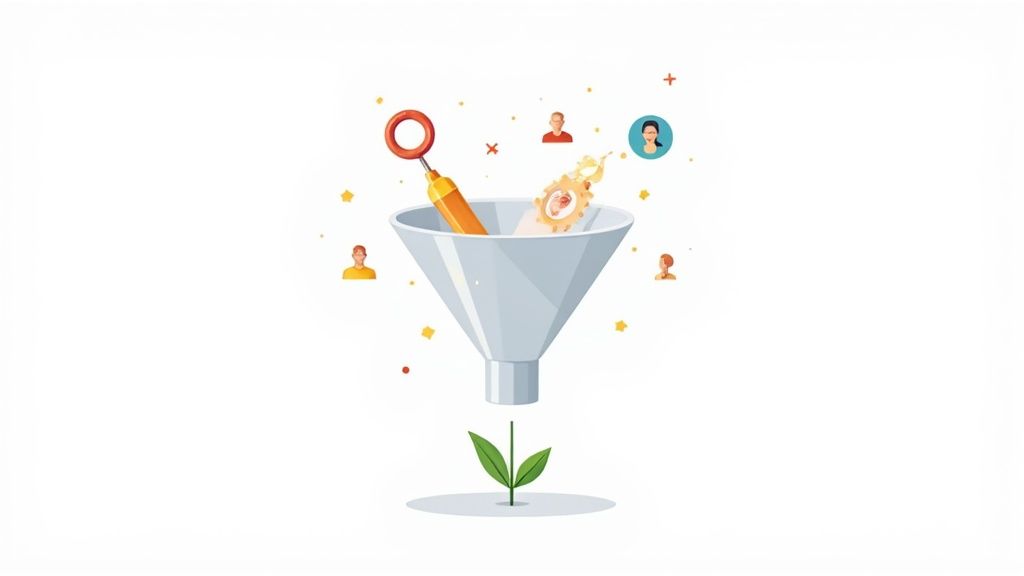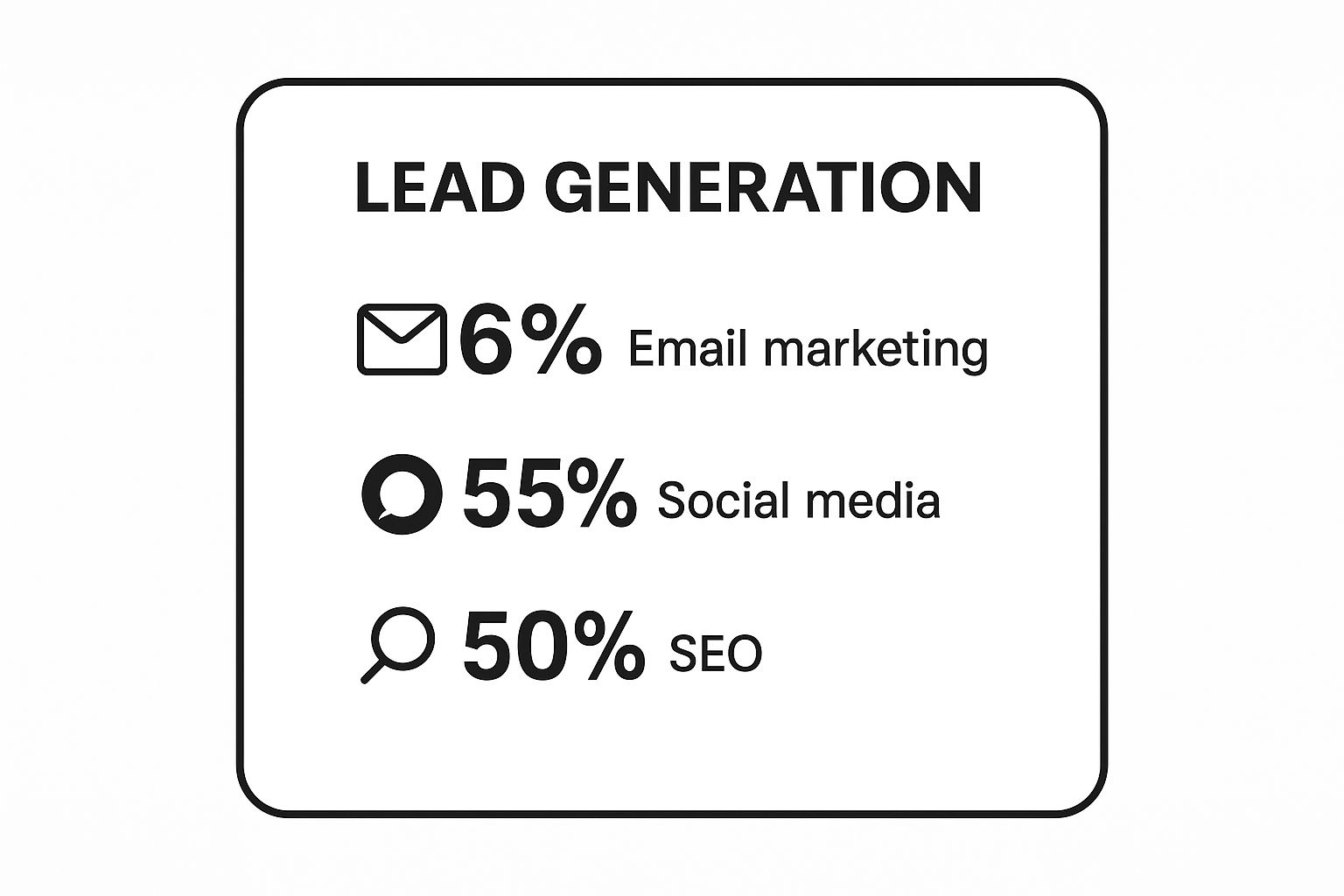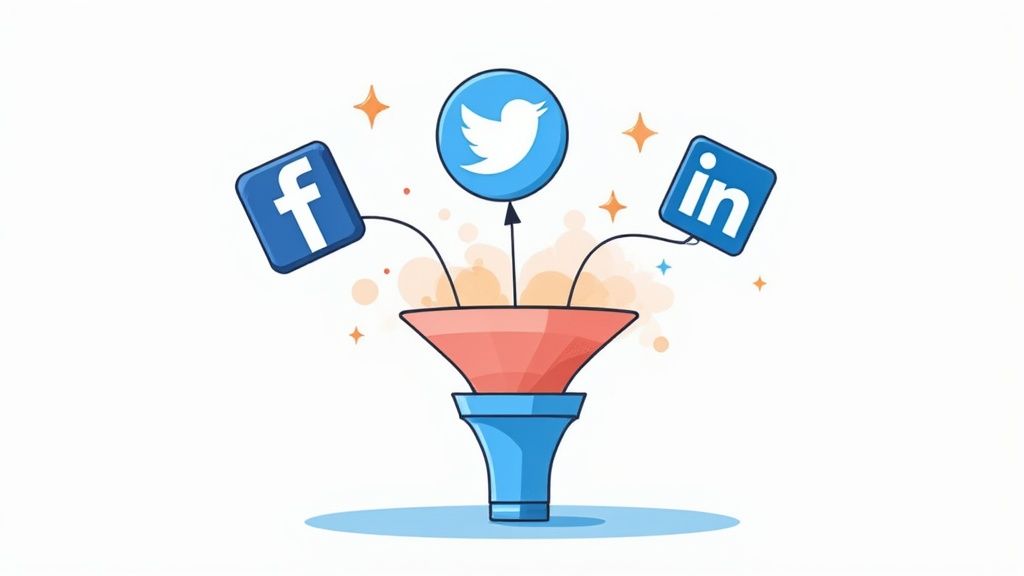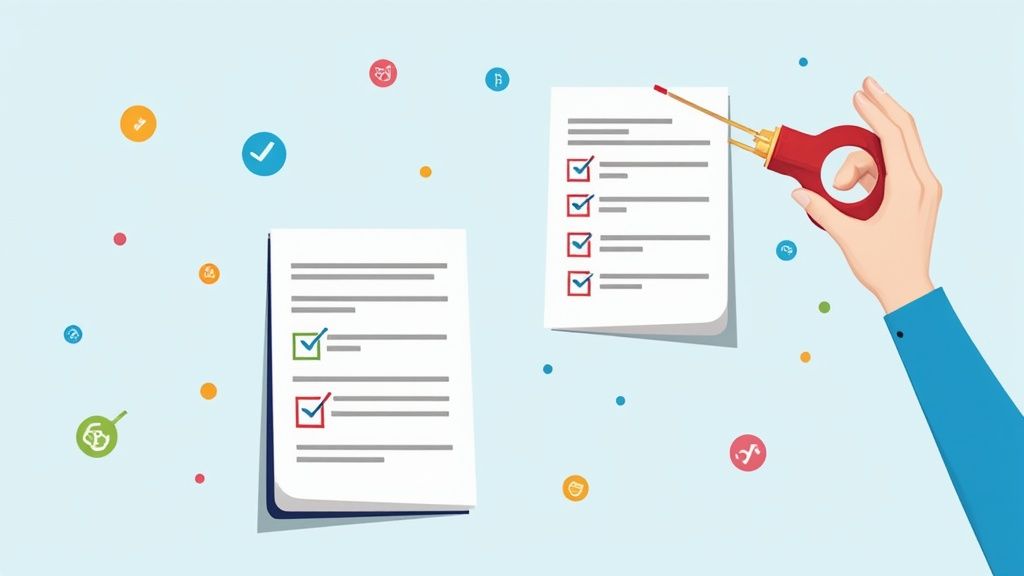How to Generate Leads for Sustainable Growth

To generate leads consistently, you can’t just throw random tactics at the wall and see what sticks. It’s about building an integrated system—a well-oiled machine where strategic content marketing, targeted social media engagement, and smart technology work together. This modern approach moves beyond one-off campaigns to create a sustainable process that turns genuine interest into real business opportunities.
The Modern Framework for Generating Leads
Forget the old, siloed way of thinking about lead generation. True success today comes from a cohesive system where your marketing channels are all playing for the same team. The whole idea is to attract, engage, and qualify the right people, not just chase vanity metrics like clicks and impressions. It’s about building relationships, not just lists.
This integrated approach really comes down to three essential pillars:
- Strategic Content Marketing: This is your foundation. It’s all about creating genuinely valuable, problem-solving content that naturally pulls your ideal customers toward you.
- Targeted Social Media: This is your engagement engine. It's where you share your content, spark conversations, and connect directly with potential leads in a place they already hang out.
- Smart Technology: This is your amplifier. Using the right tools to automate and scale your outreach lets you connect with more prospects without losing that crucial personal touch.
Building a Cohesive Lead Engine
When these three components click, they create a seriously powerful lead generation engine.
Picture this: You publish a deep-dive blog post (your content). Then, you slice it up into a compelling LinkedIn carousel (your social media). Finally, you use an AI tool to pinpoint and connect with the most engaged people who interacted with that post (your technology). See how each step flows logically into the next? You’re gently guiding a prospect from awareness to genuine interest.
This visual breaks down the most popular channels that fit squarely into this modern framework.

As the data shows, email, social media, and SEO are the heavy hitters. This just drives home how critical it is to have an integrated digital strategy where these channels support each other.
Prioritizing Lead Generation
This focus isn't just a fleeting trend; it's a business imperative. A whopping 50% of marketers count lead generation as a top priority. On average, businesses are pulling in 1,877 leads per month, and an impressive 81% of those are marketing-qualified leads (MQLs).
The real goal isn't just to generate more leads, but to generate the right leads. A modern framework prioritizes quality over sheer quantity, making sure your sales team invests their time talking to prospects who are actually a great fit for your business.
To get all these pieces working together, it's helpful to see them as parts of a single, modern engine.
Here’s a quick summary of how each component fits into the bigger picture.
Core Components of a Modern Lead Generation Engine
| Component | Primary Role | Key Goal |
|---|---|---|
| Content Marketing | Foundation & Attraction | Pull in ideal customers with valuable, problem-solving information. |
| Social Media | Engagement & Distribution | Spark conversations and build relationships where your audience lives. |
| Smart Technology | Amplification & Scale | Automate outreach and qualify leads efficiently without losing personalization. |
Understanding these roles is the first step. To really put this into practice, digging into specific B2B lead generation strategies is essential.
By adopting this integrated mindset, you'll finally move away from the frantic, one-off campaign cycle and start building a predictable, scalable system that fuels long-term growth.
Creating Content That Attacks Qualified Buyers

Content is the fuel for your lead generation engine, but only if it solves real problems for your ideal customer. Let's be honest, effective content marketing isn't about churning out random blog posts and hoping for the best. It's about crafting a message that resonates so deeply with your target audience that they start to see you as the go-to resource in your space.
You've probably heard the stats. Companies that blog regularly generate 67% more leads per month than those that don't. This isn't just luck. It happens because they're intentionally creating content that hits on specific pain points and guides readers toward a solution—your solution.
This means you have to move past generic advice and get into the weeds of what your audience truly needs. Imagine you run a B2B SaaS company trying to attract supply chain managers. A generic post on "business efficiency" is just noise. It'll get lost in the shuffle.
But an in-depth guide on "How to Optimize Logistics Workflows for E-commerce"? Now you're speaking their language. That's the level of specificity that actually moves the needle and brings in real leads.
Uncovering Your Audience’s Real Problems
Before you write a single word, you need to know exactly who you're writing for. This goes beyond a vague idea of your customer. It means creating a detailed buyer persona—a semi-fictional profile of your ideal customer, pieced together from real data and research. Don't just guess.
Your first stop? The sales team. They're on the front lines every single day, hearing about customer challenges, questions, and goals. They know what makes a prospect’s ears perk up and what makes their eyes glaze over. Their insights are pure gold.
Next, go where your audience hangs out online. Dive into forums like Reddit, find industry-specific Slack channels, or lurk in relevant LinkedIn Groups. What questions pop up again and again? What frustrations are they venting about? These conversations are a goldmine for content ideas.
The most effective way to generate leads from your blog is to find a gap in knowledge or expertise. Once you find a topic that hasn’t been over-blogged, you have an opportunity to become the go-to resource.
Turning Problems into High-Value Content
Once you've zeroed in on those pain points, it's time to build content that provides real, actionable solutions. The goal here is to be genuinely helpful, not just to push a sale.
Think about the different stages of your buyer's journey and match your content format accordingly:
Top-of-Funnel (Awareness): At this stage, people are just starting to identify a problem. Create educational blog posts, how-to guides, and checklists that answer broad questions. For our logistics example, this could be a post like, "5 Common Bottlenecks in Warehouse Management."
Middle-of-Funnel (Consideration): Now they're exploring solutions. This is where you develop more in-depth resources like case studies, whitepapers, or webinars to showcase your expertise. A perfect topic might be, "A Case Study: How Company X Reduced Shipping Costs by 15%."
Bottom-of-Funnel (Decision): They're ready to buy. Help them make the final choice with product comparisons, pricing guides, or demo videos.
This tiered approach ensures you have something relevant and valuable for everyone, no matter where they are in their journey.
Optimizing Content for Discovery and Conversion
Look, creating great content is only half the battle. If people can't find it, it doesn't exist. This is where search engine optimization (SEO) comes into play. You need to do some keyword research to figure out the exact phrases your audience is plugging into Google.
Weave your main keyword into your title, your headings, and the first paragraph—but make it sound natural. More importantly, write a compelling meta description that makes people want to click on your article from the search results page.
Finally, every single piece of content needs a clear call-to-action (CTA). This is the bridge that turns a passive reader into an active lead. Don't just slap a generic "Contact Us" button at the bottom and call it a day. Offer something genuinely valuable in exchange for their contact info.
Here are a few CTA ideas that actually work:
- Offer a Content Upgrade: Give them a downloadable PDF version of the blog post, a bonus checklist, or a handy template.
- Invite Them to a Webinar: Host a live session that dives even deeper into the topic you just wrote about.
- Promote a Free Tool: If you have a simple calculator or tool on your site, offer free access in exchange for an email.
By strategically placing these kinds of CTAs, you create a natural next step for an engaged reader. You're not just asking for their email; you're offering more help, moving them one step closer to becoming a customer.
Using Social Media to Start Real Conversations

If you're only using social media as a digital billboard for your content, you're missing the point. It's a dynamic arena for direct engagement and conversation. When you learn to generate leads on these platforms, you stop just broadcasting and actually start connecting.
The real power comes from turning your high-value content into an interactive experience.
One of the best ways to do this, especially in the B2B world, is with a LinkedIn carousel. Instead of just dropping a blog post link and hoping for clicks, a carousel breaks down your key insights into a bite-sized, visual story that people can flip through right in their feed.
Transforming Content into Compelling Carousels
Think of a carousel as a mini-presentation. The goal is to take a dense blog post, case study, or whitepaper and distill it down to its most powerful points, spreading them across multiple slides. This approach plays well with short attention spans and gets users actively swiping through your story.
A great carousel usually follows a simple narrative arc:
- The Hook (Slide 1): Start with a bold title or a provocative question. This slide needs to grab attention instantly and make a strong promise about the value they'll get if they keep swiping.
- The Story (Slides 2-9): Each slide should build on the last, revealing one key insight, statistic, or step at a time. Keep the text minimal and use strong visuals to make it easy to digest.
- The Call-to-Action (Final Slide): This is where the magic happens. Your last slide needs one clear CTA. Don't be vague; tell them exactly what to do next.
For example, if you made a carousel from a "Warehouse Management" blog post, your final slide could say, "Comment 'Checklist' below, and I'll send you our full 25-point optimization checklist." This simple prompt turns a passive viewer into an active lead. If you want to dive deeper into creating posts like this, our guide on how to get more engagement on LinkedIn has you covered.
The Power of LinkedIn for B2B Leads
Focusing on a platform like LinkedIn is a smart move for any B2B company. It’s where professionals are actively looking for industry insights and real solutions to their problems.
In fact, research shows that 53% of B2B marketers use LinkedIn to find prospects and get contact info. Plus, advertising on the platform can boost purchase intent by a whopping 33%, showing its direct impact on your sales pipeline.
A great carousel doesn't just share information; it starts a conversation. By designing your final slide to prompt a comment or a DM, you create a personal channel for follow-up, moving the interaction from a public feed to a private dialogue.
This method works so well because it meets your audience where they already are, respects their time with scannable content, and gives them a super easy way to raise their hand. Instead of asking for a click to a landing page right away, you're building rapport first. That makes the later ask for an email or a demo feel much more natural.
Scaling Your Outreach With Intelligent Automation

So, you've done the hard work. Your content is resonating, and your social media efforts are finally bringing in a steady stream of interest. But this creates a new kind of problem, doesn't it?
Suddenly, you're buried under notifications and comments. How can you possibly manage all this engagement and scale your outreach without hiring a huge team or losing that personal touch that got you here in the first place? This is precisely where intelligent automation stops being a buzzword and becomes your most valuable ally.
The whole point isn't to replace human connection but to multiply its impact. By using smart AI-powered tools, you can hand off the most repetitive, time-sucking parts of lead generation. Think of it as freeing yourself up to do what you do best: build real relationships.
Finding High-Intent Signals With AI
Let's say you just published that killer LinkedIn carousel. The likes and comments are rolling in, which feels great. But who among those people are actually potential customers? Trying to manually sift through every single interaction is not just exhausting; it’s a terrible use of your time.
This is where a tool like Lumeo completely changes the game. Instead of just looking at raw engagement metrics, you can use it to pinpoint high-intent signals. The AI gets to work, analyzing comments not just on your posts, but on other relevant industry posts, too. It’s actively looking for people who are asking buying questions or talking about the exact problems your product solves.
For instance, the AI could flag comments like these:
- "This is exactly the bottleneck we're facing. Does anyone have a good tool for this?"
- "Great breakdown. We're currently evaluating solutions to improve our workflow."
- "Thanks for sharing. This is a top priority for our team this quarter."
These aren't just idle comments—they're practically buying signals. The technology acts like your personal scout, bringing you warm leads who have already raised their hands and shown they have a need.
Automating Personalized Outreach That Works
Once you've identified these high-intent prospects, the next move is to reach out. But a generic, copy-and-pasted connection request is the fastest way to be ignored. This is where automation helps you scale personalization, not get rid of it.
You can set up campaigns to automatically send connection requests on LinkedIn, but the magic is in crafting templates that feel genuine and human. The best outreach messages always reference a shared context.
A successful automated message doesn’t sound automated. It feels like a natural continuation of a conversation that has already started, referencing the specific post or comment that caught your attention.
Here's a simple but incredibly effective template structure you can adapt:
Template Example: "Hi [First Name], I saw your comment on [Original Poster's Name]'s post about [Topic]. Your point about [Specific Detail from their Comment] really resonated with me. I've been exploring that space as well and thought it would be great to connect with like-minded professionals. Looking forward to it!"
This approach instantly shows you’ve paid attention. The AI does the heavy lifting of finding the person and kicking off the outreach, but the message itself is rooted in a real interaction. It feels personal and relevant.
By blending smart technology with authentic communication, you can build a scalable system that consistently turns online chatter into meaningful business conversations. To dig deeper into how technology can streamline this entire process, you can explore proven strategies for automating lead generation. This outreach is just one piece of your marketing puzzle; learn more about how it fits into broader content promotion strategies to create a powerful, cohesive plan.
How to Measure and Optimize Your Lead Funnel
Getting activity is the easy part. Likes, shares, and views feel good, but what really matters is whether your efforts are translating into actual results for the business. To figure that out, you have to look past the vanity metrics and dig into the numbers that truly impact growth.
The health of your entire lead funnel is revealed by just a few key metrics. I'm talking about things like lead quality, the conversion rate of your content, and your cost per acquisition (CPA) for each channel. This is the data that tells you where your best leads are coming from and exactly how much you're spending to get them.
Identifying Your Key Performance Indicators
Before you can start optimizing anything, you need to be crystal clear on what success even looks like. It's easy to get buried in data, so don't try to track dozens of different things at once. Just start with a few critical metrics that give you a clean, honest picture of your performance.
Your core metrics should always include:
- Visitor-to-Lead Conversion Rate: Of all the people who land on your blog post or landing page, what percentage actually fills out your form? This is your first real test of how compelling your content is.
- Lead-to-Customer Conversion Rate: Out of all those hard-won leads, how many go on to become paying customers? This is the ultimate report card on your lead quality.
- Cost Per Acquisition (CPA): How much marketing spend does it take to acquire one new customer? Knowing your CPA for LinkedIn ads versus, say, organic search, is how you start making smarter budget decisions.
Of course, to get these numbers, you have to be meticulously tracking conversions. For anyone running a store on a platform like Magento 2, that means getting your hands dirty with tasks like setting up conversion tracking for e-commerce.
A Simple Framework for A/B Testing
The name of the game is continuous improvement. A/B testing, also known as split testing, is a beautifully simple way to compare two versions of something to see which one performs better. It’s a data-backed approach that takes all the guesswork out of the optimization process.
The key is to start small by testing one high-impact element at a time. For instance, you could pit two different headlines against each other on a landing page. Or maybe test two different calls-to-action (CTAs) in an email, or even two variations of ad copy on social media.
By changing only one variable at a time, you can confidently attribute any performance difference to that specific change. This creates a feedback loop of constant, incremental improvements that compound over time.
This disciplined approach is what turns your lead generation from a shot in the dark into an efficient, profitable machine. For a much deeper dive, check out our guide on measuring content performance to really start turning your data into action.
Of course. Here is the rewritten section, following all the specified requirements for a natural, human-written tone and style.
Your Top Lead Generation Questions, Answered
Even with the best strategy laid out, you're bound to have questions. I get it. When you're in the trenches of lead generation, new challenges always seem to pop up. Things like balancing lead quality with quantity, figuring out which channels are actually worth your time, and knowing when to hit the gas can feel like a constant juggle.
Let's walk through some of the most common questions I hear from businesses just like yours.
One of the first things everyone wants to know is, "How long will this take?" It's a fair question. The honest answer? Lead generation, especially the good kind that comes from organic content and SEO, is a long game. While you might get a quick hit of traffic from a social media post in a few weeks, building a truly sustainable engine takes real dedication.
You should be prepared to put in three to six months of consistent work before you see a reliable flow of leads. It’s all about patience and consistency. Remember, there's a reason companies that blog regularly generate 67% more leads per month than those that don't. That doesn't happen by magic; it's the payoff for building real authority and trust over time.
How Many Leads Do I Actually Need?
This is the million-dollar question, isn't it? The truth is, the "right" number is completely unique to your business. Instead of pulling a random number out of the air, the smart move is to work backward from your revenue goals.
It all starts with asking the right questions:
- What's our monthly or quarterly revenue target?
- On average, what's a new customer worth to us over their lifetime (LTV)?
- Historically, what percentage of our leads turn into paying customers?
Once you have these numbers, the math becomes surprisingly simple. Let's say your goal is $20,000 in new revenue. If your average customer is worth $2,000 and your sales team converts 10% of qualified leads, you know you need 100 solid leads to hit your goal.
See? It's a data-driven target, not a wild guess. This approach is worlds more effective.
Which Lead Generation Channel Is Best?
I wish there were a single "best" channel, but there isn't. The ideal mix really boils down to your industry and, more importantly, your audience. A B2B SaaS company will almost certainly crush it on LinkedIn, while a direct-to-consumer brand selling handmade jewelry might find its home on Instagram or TikTok.
Instead of asking which channel is best, ask yourself: Where does my ideal customer already hang out? The most effective strategy is to show up where your audience is already looking for answers and solutions.
My best advice? Start small. Pick one or two channels you know you can manage well. Once you've got a solid process down and are seeing some wins, then you can start branching out. Don't spread yourself thin trying to be everywhere at once. Focus, master, and then scale. That’s how you get real impact.
Ready to turn your content into a lead-generating powerhouse? With Lumeo, you can effortlessly transform articles, videos, and even tweets into compelling carousels that capture attention and drive action. Stop just sharing content and start creating conversations. Try Lumeo for free and see how easy it is to scale your lead generation.